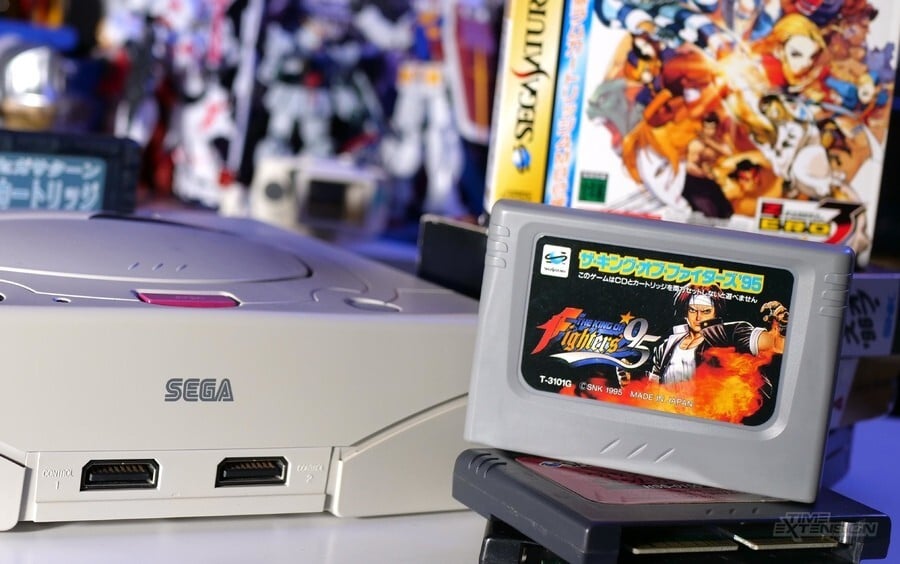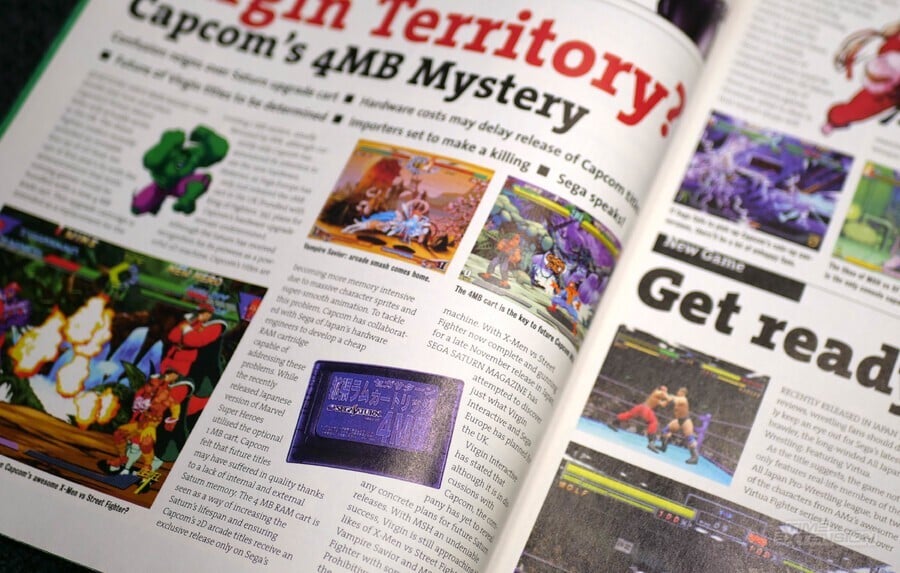
When the first official images of the Saturn appeared around 1994, one aspect of the console's design caught the attention of some people: the cartridge slot. It led some to assume that the machine would be backwards compatible with the Mega Drive, or that it would support both CDs and cartridge-based Saturn software.
The reality was somewhat more mundane – the port was initially used for a back-up memory cart which expanded the console's amount of save data storage – but that didn't stop it from briefly triggering some excitement amongst Sega fans, and it would (eventually) be used for something a little more interesting.
In 1996, SNK announced it was porting its popular King of Fighters '95 arcade machine to both the Saturn and PlayStation, with the Sega port offering a significant advantage. It would ship with a ROM cartridge containing a portion of the game's data, which the console was capable of accessing faster than pulling it from the CD. However, due to the fact that the cartridge was unable to hold all of the data, the disc was still used, with information being pulled from both media types.

The end result of this "Twin Advanced ROM" hybrid approach was a more faithful conversion that not only featured better animation than the PS1 port, but also had much shorter load times. Only one other title used the Saturn's cartridge slot in this way – Ultraman: Hikari no Kyojin Densetsu – but that never left Japan. Amazingly, while King of Fighters '95 didn't get a North American release, it was published in Europe.
The ROM cartridge was an ingenious solution to the issue of data access and long load times, but it had one key problem: cost. The ROM cart could only be used with a single game and drove the cost up significantly. Thankfully, Sega came up with another solution that took a similar approach but could be used on multiple games: the HSS-0150 1MB RAM cartridge.
This added another 1MB of work RAM to Saturn's internal 2MB, which meant the console had more memory to use for game data. This cart was bundled with the likes of King of Fighters '96, Samurai Spirits Amakusa Kourin, Real Bout Garou Densetsu / Fatal Fury, Metal Slug, Fighter's History Dynamite and Groove On Fight: Gouketsuji Ichizoku 3. The beauty of this approach was that you could sell games both with and without the cart, as Saturn owners only needed to own a single 1MB RAM cartridge and use it across multiple games. There were even titles like Marvel Super Heroes and Cyberbots, which would run without the cart but featured improved animation and shorter load times when it was used.
In 1997, Sega took this concept a step further with the 4MB HSS-0167 cartridge, which launched alongside the Saturn port of X-Men vs Street Fighter. This took Saturn's work RAM to a whopping 6MB, allowing for arcade-perfect ports of the latest 2D fighting games. Capcom released Marvel Super Heroes vs. Street Fighter, Vampire Savior: The Lord Of Vampire, Final Fight Revenge, Dungeons & Dragons Collection and Street Fighter Zero 3 with support for the cart, which would also work with (most) games that required the 1MB cartridge (some 1MB games displayed corrupted visuals when used with the 4MB variant).
Capcom and SNK, in particular, leveraged the RAM cart to produce peerless home conversions of their biggest games, which were also released on PS1 simultaneously. However, comparing any RAM cart game released on both systems was an exercise in humiliation for Sony; for example, the PS1 ports of X-Men vs Street Fighter and Marvel Super Heroes vs. Street Fighter lack the signature tag-team mechanic as the console couldn't fit four different fighters into its RAM. The Saturn ports exhibit no such problems, thanks solely to the 4MB RAM cartridge.
Having such a powerful weapon in its arsenal helped Saturn gain consumer support in Japan, where 2D fighting games were still one of the most popular genres – but, in the West, the cartridge was sadly never released. By 1997, Sega's position in both North America and Europe was precious, to say the least, and the notion of spending precious money on manufacturing physical RAM carts for such a small audience didn't find much favour with the walls of Sega of America and Sega Europe. Magazines at the time reported that a release was at least being considered, while the Western version of Marvel Super Heroes actually includes support for the RAM cart – but sadly, it never happened.

Ultimately, both the 1MB and 4MB cartridges remained exclusive to Japan, where the console continued to sell in modest numbers up until the launch of its successor, the Dreamcast. Would they have made any difference to Saturn's fortunes in the West had they been released here? It's highly unlikely, as the kind of games that used the RAM carts weren't the type of titles that would have sold in huge numbers in North America and Europe.
Instead, these innovative expansion devices made Saturn feel more exotic and exciting to the small group of Western importers who supported the system right until the bitter end. The notion of expanding the base memory of a console didn't die here, though; Nintendo would release its own take on the concept – 1998's Expansion Pak, which added 4MB of RAM to the console's memory, doubling it 8MB.
